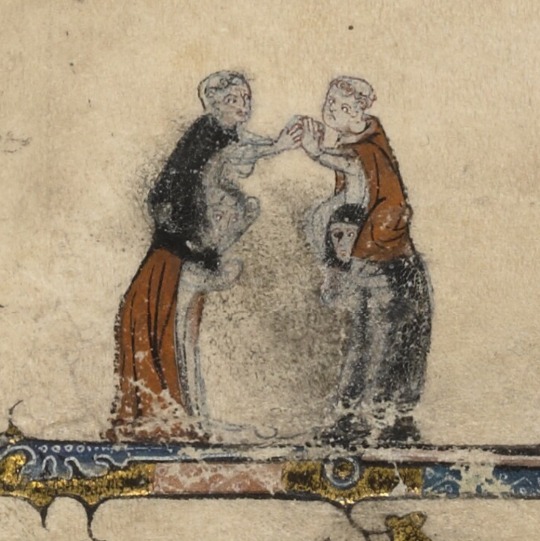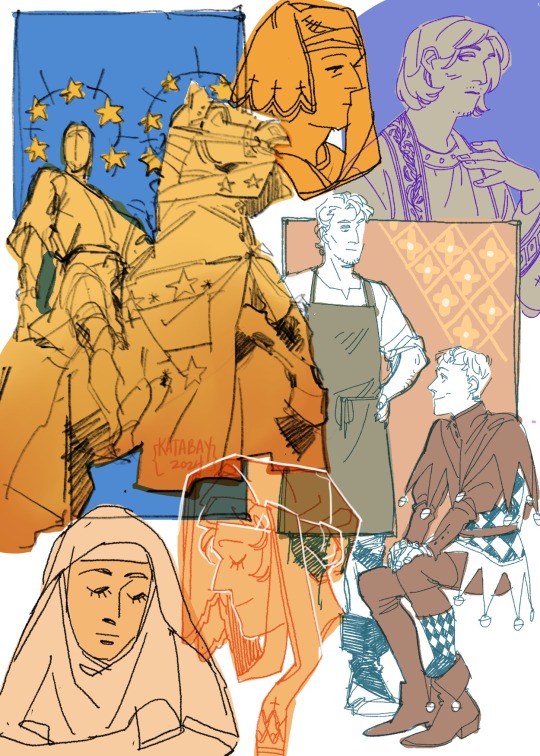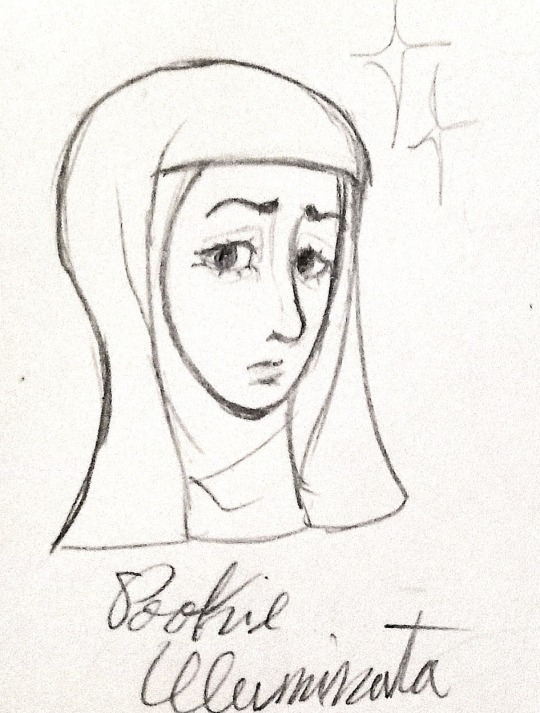#medieval nun
Explore tagged Tumblr posts
Text

Bodleian Library MS. Bodl. 264 f.3r
Some nuns and monks playing shoulder wars
#medieval#medieval manuscripts#middle ages#illuminated manuscript#cloistercore#medieval monk#medieval nun#nun#monk#monkposting
425 notes
·
View notes
Text

Ayumi and Agon. From July 2024
#rosariumoccultum#original character#dnd character#worldbuilding#dnd#dungeons and dragons#d&d 5e#monasticism#pixel art#dnd art#medieval#medieval fantasy#medieval character#nun#medieval nun#the kiss#gustav klimt#art parody#art trend
12 notes
·
View notes
Text

sketch page time, but make it medieval! I was messing around with a composition for a knight, and the blacksmith and the jester and also the lady (who is an assassin) were some early early early ideas for characters! someday they may even exist in a story that has a plot.
⭐ places I’m at! bsky / pixiv / pillowfort /cohost / cara.app / tip jar!
#I got Several Requests for the medieval genre so we’re continuing the queue with another entry into the genre#generic medieval tag#I keep thinking about doing something with lesbian nuns in honor of the lesbian nuns but a friend suggested making them an assassin#so now I’m turning new Possibilities around in my head#we’ll see! the blacksmith and jester were about thoughts i had wrt to medieval taxes and espionage#not so much a queue as this is a blender of scheduled posts set for random hours#<< the queue tag because it’s not really a queue. I’ll delete it when I return from freelancing and commission work
414 notes
·
View notes
Text


✴︎ fantasy godtier stuff
#idk if i like the way the jade one came out or not but she's serving medieval nun#homestuck#myart#homestuck fanart#jade harley#dave strider#june egbert#john egbert#beta kids#fantasy art#knight of time#heir of breath#witch of space#fanart#god tier#homestuck au
76 notes
·
View notes
Text

A secret farewell
192 notes
·
View notes
Text




uhhh here is my elaborate fiction about a world with loopholes that let women be priests and marry nuns. look at my butch priest. i am slightly obsessed
#digital art#ocs#oc art#artists on tumblr#medieval fantasy#comic#original characters#priest character#butch priest#nuns#priests and nuns#religion aesthetic#hierophilia#priest art#oc:ellis
96 notes
·
View notes
Text

In medieval France, a nun's meowing led to a convent-wide phenomenon where all nuns meowed together for hours, causing alarm in the community until soldiers intervened to stop the behavior.
#medieval history#mass hysteria#meowing nuns#French convent#psychological phenomena#historical events#Middle Ages#unusual occurrences
71 notes
·
View notes
Text
Pentiment





here are the nuns!
60 notes
·
View notes
Photo

"Hildegard von Bingen" (19th century) by Unknown ✧ A Benedictine visionary at her instrument
35 notes
·
View notes
Text

François Gérard, after (French, 1770-1837) Saint Teresa of Avila, 1827 Infirmerie Marie-Thérèse Saint Teresa of Avila (1515-1582) was a Carmelite nun born in Castile during the sixteenth century. In her writings Teresa recorded a vision of an angel plunging a long golden spear or arrow with a flaming tip into her heart. This symbolic implanting of amor dei was mentioned in the papal bull of her canonisation (1622) and became the most popular motif in representations of the saint after this date: the most famous of these is undoubtedly Bernini's marble sculpture in the church of Santa Maria della Vittoria, Rome.
#spanish nun#saint teresa of avila#aragon#carmelite nun#castile#st teresa of avila#François Gérard#French#France#1700s#1800s#saint#sainthood#christian#christian art#christianity#christentum#catholic#catholic art#catholicism#roman catholic#cermelite#medieval#spain#spanish#st teresa#western civilization#art#europe#fine art
129 notes
·
View notes
Text

British Library, Add MS 42130 f.51v
An abbess
#medieval#middle ages#medieval manuscripts#illuminated manuscript#cloistercore#medieval nun#nunposting
106 notes
·
View notes
Text
Ayumi, Agon, and Emerentiana. From October 2024
#rosariumoccultum#original character#dnd character#worldbuilding#dnd#dungeons and dragons#d&d 5e#monasticism#pixel art#dnd art#medieval#medieval fantasy#medieval character#nun#medieval nun#weirdcore#doomed yuri#toxic yuri#my art#edit#capcut
5 notes
·
View notes
Text

#Häxan [1922]#Häxan#1922#20's#20s#silent horror essay film#witchcraft#Häxan:Witchcraft through The ages (1922)#demons#witches#primitive#medieval culture#nun#priest#evil#devil#satan#my gifs#my gif#gif#b&w film#b&w movies#movies
158 notes
·
View notes
Text
though, lingering over that last post....I wonder how easily this trips into horror story? I mean, in this world where there are child-producing marriages and then sisterhoods/brotherhoods for the rest, this obviously allows the family to keep a stranglehold on their collective assets and wealth. Therefore, I bet that family is an even more tightly-locked cage for those born into it.
Oh, you thought that if you could just escape marriage you'd be free, didn't you? You thought you could join the local order and letter manuscripts or tend goats or say prayers over the dying---but no. No, that's for other people's sons and daughters. You have no escape. You will serve your family forever, whether you will or no. You marry who they tell you to and live in your family's third-nicest castle your whole life; you can have as many lovers and bastards as you want, you can earn coin all on your own, if you can, but it will come to naught in the end. You will be cursed with absolute surety of where you fall: res nullius.
As it was and ever shall be, amen.
#and the reverse! no longer is becoming a monk or a nun a way to try and climb the ranks of a highly stratified system#because the wealthy nobles don't dump their spares into the church and pay for them to be abbot of wherever#instead they push them into brother/sisterhoods#where they don't have to worry about losing access to those familial assets long term#the question is then - if this system is so good at keeping everyone inside it#how does it break. where does it break.#I think you could do some real gender fuckery with this concept as well but I'd have to think about how#........also we'd probably have to change some probate law around. because there's no way that your third son#should be able to bequeath YOUR castle to his illegitimate son#even if you did give it to your son and his 'brother' on their wedding day.#I'd have to get really into medieval wills though and who has the time.#(I'm avoiding work can you tell?)#for my own purposes
127 notes
·
View notes
Text
THE SORROWS OF MILICA NEMANJIC OF SERBIA

Though often remembered for her diplomacy and regency (1389-1393), one thing some sources and historians fail to mention about Princess Milica is her struggles with motherhood and widowhood, even through her politics.
Early Life
Milica was born sometime in 1335 as the daughter of Duke Vratko, known in Kosovo legends as Jug Bogdan, a descendant of the Nemanjić dynasty; however, the identity of her mother is unknown.
In her early years, Milica would often stay at the court of her cousins, Tsar Dušan and Tsaritsa Jelena. The couple took a liking to her, sponsored her stay at court, and provided her education, thus she permanently settled at court.
It is at the same court where she had the opportunity to meet Lazar Hrebeljanović, six years her senior and, at the time, a young man of lower nobility working as a puter/stavilac.
According to a legend, Milica met Lazar at the same place where she would later build the Ljubostinja Monastery.
There could be some truth to this tale, but it is worth noting that they were likely introduced at court by the same couple who planned for them to marry.
Marriage to Lazar
Sometime in 1353, Milica and Lazar were married by the wish of Dušan and Jelena and with the blessing of her father. The mere fact that the imperial couple arranged their betrothal suggests that Lazar was a well-respected man enough to join the Nemanjić dynasty by kinship.
Though the marriage was for political purposes, as it elevated Lazar’s status and reputation, it is understood through Milica’s poem that they had grown to hold deep affection and value for each other.
Through her poem “To My Widow, O Bridegroom,” it can be understood that Milica viewed Lazar as someone she desired, admired, and found comfort and protection in.
It is worth mentioning that Milica was one of the many reasons Lazar (r. 1365-1389) was able to elevate himself to the title of Prince (Knez) and expand his realm. While his rivals claimed the rest of Serbia due to their Nemanjić ancestry, Lazar, who was not one of their own, likely had to rely on his wife and children’s claim to the “holy” dynasty to gain the trust of the Serbian people.
Throughout their 36-year-long marriage, the couple welcomed eight children, five daughters and three sons, though only seven made it to adulthood.
Mara Lazarević (b. 1355 - d. 1426)
Dragana Lazarević (b. sometime after 1355 and before 1364, d. sometime after 1396)
Jelena Lazarević (b. 1364/1365 - d. 1443)
Teodora Lazarević (b. after 1365 and before 1371, d. after 1396 and before 1405)
Olivera Lazarević (b. 1372/1373 - d. after 1444)
Stefan Lazarević (b. 1377 - d. 1427)
Vuk Lazarević (b. 1380 - d. 1410)
Dobrovoj Lazarević (died in infancy)
It seems that the couple enjoyed a harmonious and faithful marriage, as there are no mentions of a mistress or illegitimate children that Lazar could have fathered.
Her Widowhood and Regency
Following the defeat at the Battle of Kosovo in the summer of 1389, Lazar was ordered to be beheaded, leaving behind a venerable realm and his wife at the forefront.
Since his son and heir was too young to be entrusted with the duty of ruling, the Principality of Serbia fell into the hands of the Dowager Princess, Milica.
Though it is possible that Milica might have been educated in diplomacy, she certainly did not have any first-hand experience up until that point. Her primary duties as the wife of a prominent ruler were to expand the dynasty by child-bearing, oversee her children’s education, manage the royal court’s income and expenses, and participate in charities such as hospitals and monasteries—duties in which Milica, as a dutiful mother and consort, excelled.
Constantine the Philosopher described her in the following words: “…pious lady, worthy of glory and wise mother, who surpassed many chosen mothers."
At first, Milica, a fearful mother and mourning widow, wasn’t much interested in staying in Serbia and planned to take temporary refuge with Olivera, Stefan, and Vuk, her youngest children, in Dubvronik, this is evident by a document in which the Senate offered her and her children hospitality.
Unfortunately, her plans had to be annulled as the Hungarians advanced their conquest in the north of Serbia and the Ottomans to the south of it. Thus, her final decision was to stay, and sometime between November and December of that same year, she accepted vassalage to the Ottomans despite the reluctance of many Serbian lords, including her son-in-law, Vuk Branković (through Mara), a decision that would cost the Branković family their lands.
The vassalage included loyalty, taxes in the form of soldiers, and lastly, her youngest daughter, Olivera, to be the wife of the Sultan. All requirements were met, as by the spring of 1390, her daughter was married to the Sultan.
Milica continued to rule over Serbia for three more years, until her eldest son Stefan reached adulthood in 1393. That year, she became a nun under the name "Eugenia," yet she continued to advise her son behind the scenes, as evidenced by her diplomatic mission with her cousin and lady-courtier, Jefimija, to Sultan Bayezid in the spring of 1398 when he suspected Stefan of treason.
The issue was soon resolved, and Stefan was forgiven.
Her Motherly Sorrows Though things seemed to be going quietly from 1398 onward, the peace came to an end in 1402, following the Battle of Ankara.
While her beloved son, Stefan, was able to elevate himself to the title of Despot in Constantinople, her son Vuk, wishing for more territory to rule over, revolted against his brother. Additionally, her daughter Olivera and her granddaughters fell into Timurid captivity.
Milica’s daughter Mara, along with her respective children, developed a vendetta against the Lazarević family, whom they blamed for Vuk Branković’s death.
All these stresses likely prompted her to write her poem “To My Widow, O Bridegroom,” dedicated to her husband, Lazar, in 1402. Amid all the motherly worries and family vendettas, it seems that the memory of her deceased husband was what she found comfort in.
Later Life
When the Ottoman civil war broke out between Bayezid’s sons, Vuk and Stefan found themselves on opposite sides of the conflict, supporting different Ottoman rulers.
Milica was able to reconcile her sons; however, after her death, their bloody feud reappeared.
Milica passed away on November 11, 1405, at the age of seventy and was laid to rest in the Ljubostinja Monastery.
Perhaps in her final days, she was at ease since her daughter Olivera was released, and her sons “ended” their vendetta. However, it seems, based on what happened soon after her death, that they only did so for the sake of their mother.
Legacy
Milica has left her mark on Serbian history, being declared a saint in the Eastern Orthodox Church. Today, many statues, church venerations, and streets are named after her.
Poem of Milica to Her Husband

Who is this? Speak into my ears. Is this the one I desired before, my adornment, the gathering for my scattered children? Is this the one whom out of envy the enemies sought to destroy and keep the light of my sight in dark dungeons, and they could not? Is this the one to my widow, O Bridegroom? Come, O Bridegroom, come, and repay those who do me wrong according to their deeds, for they did not understand your coming to my aid. Take up the weapon and rise, and do not delay! Strike with sharpened arrows into their hearts, those who have sharpened them against me, the lawless. I do not tolerate the mockery of those against me. With how many vile sacrifices have they defiled me! Come, avenge me with your blood. Come, be my support in my downfall. Gather my scattered children, whom envy the devil has torn from me. Gather them into my fold, tend to my children, that the wolf may not eat from my flock, that envy may not scatter them, as before, when I was not with them. Do not let them sleep around you. Do not let your legs weaken. Tend to my flock, which I entrusted to you. Drive away from them the lawless barbarians. Do not cease to fight with them for me and my flock. Rejoice, my eye that never sleeps, O Lazar. And again I ascend to the first. Lazar, who surpasses all stars with his shining, Lazar, appropriator to foreigners, preacher of the Trinity, liberator of the captured. Lazar, the unwavering pillar of the church, healer to the sick, clothing to the naked, Lazar, strong duke to the innocents and savior. Rejoice, O Lazar apostolic, I sing to you, and again I say: rejoice. Rejoice, lily that has sprouted from thorns, unconquerable weapon for soldiers. Rejoice, teacher to the hermits. Rejoice, Lazar, to those who sail, steersman and calm harbor. Rejoice, avenger of the oppressed and denouncer of the deceitful. Rejoice, comforter of those who weep, and defender of the poor, and clothing to the naked. Rejoice, strength of beauty, and sustainer of widows. Blessed indeed are you, O Lazar, bless me who blesses you. There is no praise that you are not worthy of, but the mind grows weary...
(Sources: Dve srpske sultanije : Olivera Lazarevic (1373-1444) : Mara Brankovic (1418-1487) by Giljen, Nikola)
#milica of serbia#milica hrebeljanović#milicanemanjic#Medieval Serbia#medieval history#medieval poem#history#nun#THE SORROWS OF MILICA NEMANJIC OF SERBIA
43 notes
·
View notes
Text

tfw your hopeless crush turns into a hopeless lesbian crush
#digital art#ocs#oc art#artists on tumblr#medieval fantasy#illustration#comic#priests#nuns#religion aesthetic#wlw art#butch lesbian#is there a tag for butch priests#i read that sweden has more women priests than men and blacked out#oc:ellis
78 notes
·
View notes